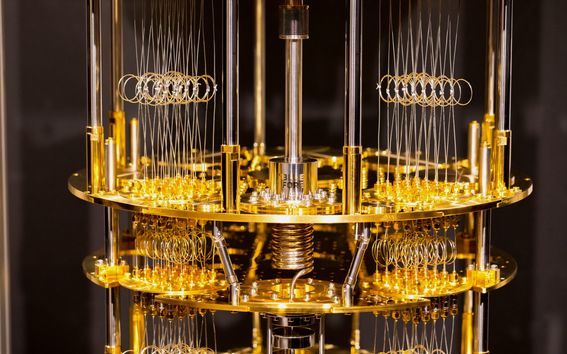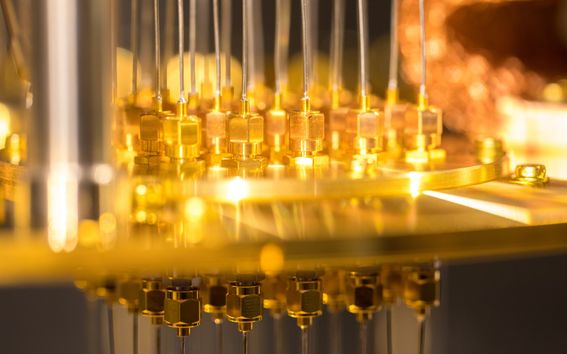Finnish Quantum Institute announced
InstituteQ will coordinate research, teaching and commercialisation across Finland

Today, Finland launched its second quantum computer! This 20-qubit superconductive device is a result of intensive joint technology development between VTT Technical Research Centre of Finland and IQM Quantum Computers; a spinoff of Aalto University and VTT.
To celebrate the milestone we're republishing some great quantum stories from our aalto.fi archives. And if you want to know more about the new quantum computer, you can find the press release here.
******************************************************************************************************
(Originally published in Aalto University Magazine Apri 2021)
Quantum physics is more than just experiments in multimillion-euro particle accelerators or strange deep-space phenomena. Applications based on quantum physics are already a part of our daily lives.
This is, however, only the beginning.
Quantum computers, quantum networks and quantum sensors are becoming a reality. They have the potential to massively disrupt humanity’s ability to process information and, over time, our everyday lives as well.
Yet quantum physics remains a foreign concept to most laypeople.
Sabrina Maniscalco, Professor of Physics at the University of Helsinki, Adjunct Professor of Applied Physics at Aalto University and Vice-director of the Academy of Finland Centre of Excellence in Quantum Technology, is working to rectify this issue.
In a project led by Maniscalco, researchers built an open web platform called QPlayLearn (qplaylearn.com).
This website, created with support from IBM and the research team’s firm Algorthmiq, provides information on the basic concepts of quantum physics for learners starting at the high school level.
According to Maniscalco, understanding quantum physics is made more difficult by the language we speak. Human linguistic metaphors derive from a world of clear cause-and-effect relationships to which we are accustomed in everyday life.
This is why a fresh approach is necessary.
‘We believe that anyone can understand the key dimensions of quantum physics,’ says Maniscalco.
Sabrina Maniscalco says that we cannot lean on our everyday experiences when adopting quantum physics. How could we, from our own experience, ever grasp that before particles are measured they can be located in many different places simultaneously?
‘Today, however, there are many multimedia tools on offer: interactive digital tools, animations, videos and, of course, games.’
Maniscalco says this is precisely what makes the QPlayLearn project so special.
Its aim is to build a whole new kind of toolkit for conveying complex information. In addition to games, animations and video presentations, the site also offers articles that explain quantum phenomena and related mathematics.
Quantum Playground is one of the video games available on QPlayLearn. The colourful game looks at quantum superposition and the behaviour of the wave function. According to Maniscalco, the player experience grows even stronger in the virtual reality (VR) version, where the player is submerged in quantum phenomena taking the form of changing patterns of light and colour.
‘That is what experiencing the quantum means. We are creating and developing a new language that transcends metaphors and becomes an experience.’
Professor Pertti Hakonen shares Maniscalco's view that it would be wise for the citizenry to keep abreast of advances in quantum technology.
Hakonen and his colleagues at Aalto's Department of Applied Physics are working on, for example, superconducting quantum circuits, quantum computing and quantum thermodynamics.
‘Pretty much all of our research involves the Planck constant, only the degree with which a quantum aspect applies varies,’ says Hakonen.
By Planck's constant, Hakonen refers to a value defined in 1900 by the German physicist Max Planck that expresses the size of the packets, or quanta, in which energy can be measured. Planck’s breakthrough is what launched the development of what we today call quantum theory, which Hakonen’s own work continues to contribute to.
Hakonen's research team recently developed a new thermoelectric method in collaboration with Chinese, Russian and American physicists. This method enables distant metal electrodes to interact through quantum entanglement.
Their paper, published in the journal Nature Communications in January 2021, marks one step towards general-purpose quantum computers of the future.
Recent research discoveries at Aalto University’s Otaniemi campus also include more efficient ways to read quantum bits, or qubits, on which the massive computing power promised by quantum computers is based.
‘People should know that the computing capacity of computers will grow enormously.’

For years, the idea of general-purpose quantum computers was merely a theory discussed in university laboratories. It is only in recent years that this theory has begun to be put into practice.
One of the most significant breakthroughs came in late 2019 with Google’s Sycamore quantum processor. Google said its 53-qubit device took just over three minutes to perform a calculation that would have taken the world’s strongest supercomputer at the time, Summit, 10 000 years.
In December 2020, China, known for its quantum technology investments, reported that its Jiuzhang quantum computer had performed in only a few minutes a calculation that would have taken a supercomputer 2.5 billion years.
Such improvements in performance demonstrate the possibilities that the future of quantum computing can bring.
Hakonen says that information security is one of the most obvious applications for quantum computing that will concern us all. The quantum computers of the future can crack the most employed encryption methods of today almost trivially using the so-called Shor algorithm.
All information encrypted at present can then be decrypted with ease, Hakonen observes.
No one can yet say with any certainty when the time of general-purpose quantum computers capable of cracking existing encryption methods will come. Data security solutions that can withstand the number-crunching abilities of quantum computers are already being developed.
In Finland, research is being carried out as part of the joint VTT Technical Research Centre of Finland, Aalto University and University of Helsinki project Post-Quantum Cryptography, for example.
This year will also see the completion of the first phase of a quantum computer commissioned by VTT. It is being delivered by IQM Finland, a firm that got started at Aalto University. This domestic quantum computer will represent an important milestone for Finnish quantum technology research.
The quantum device will be constructed at Micronova, the micro- and nanotechnology building at Otaniemi, and will at first have a capacity of five qubits, with the goal of increasing this to 50 qubits by the end of 2024.
The state-of-the-art scientific refrigerators, or cryostats, used to cool its quantum circuits will be supplied by the world-leading Bluefors company, which started out at the Helsinki University of Technology.
‘Bluefors emerged from our Low Temperature Laboratory some fifteen years ago,’ says Hakonen.
He points out that the vast expectations associated with quantum computers are evident both in heavy recruitment of researchers by companies in the field and the availability of early-stage capital investment.
‘How the industry will eventually develop is a more difficult question.’
Refrigerator-sized quantum computers won’t be taking the place of our laptops or mobile phones. Quantum computation requires carefully selected special problems that can be written as an algorithm utilising quantum properties.
The effect quantum computers will have on our daily lives will be based on the possibilities of high-performance computing.
Suitable challenges for quantum computers include research into new materials or chemical compounds. For example, it is difficult to model drug molecules efficiently with traditional supercomputers.
Hakonen says quantum computing is also a good fit for urban traffic flow management or climate change forecasting.
Known as a commercial pioneer in the field, the firm D-Wave Systems in Canada is already developing supersimulators that utilise quantum technology for use in, for example, flight control, an application area with complex optimisation problems.
However, while based on quantum cooling, D-Wave's solutions are not true quantum computers in the same sense as the VTT device.
‘There is no need for a general-purpose quantum computer in flight control. A system that can be programmed to handle the problem at hand is enough.’
As application areas expand, knowledge of the basics of quantum physics is needed in more and more professions. Aalto University is already offering a bachelor's programme in quantum technology.
According to Hakonen, there are also gaps in the teaching of this rapidly advancing field. For example, courses in quantum algorithms are not yet available.
‘We need programmers who know how to program quantum computers and sensors based on quantum technology.’
Quantum sensors, enhanced by quantum algorithms, are emerging as an important application area for quantum technologies. More accurate measuring devices offer possibilities in seismology, mineral exploration and material industry troubleshooting, for example.
One of the most exciting areas of application for quantum sensors is the human body. There are many gaps in our knowledge of the activity of the 86 billion neurons our brains are made of, for instance.
At Aalto University, for example, new types of head-adaptive sensors for measuring the magnetic fields of the brain have been studied. At best, the results are almost as accurate as taking measurements inside the skull.
Hakonen says that quantum-amplified sensors are, at this early stage, still so expensive that price limits their use. Later, however, application of the sensors may extend to mass products. In the VR realm, for example, exploiting them can open up entirely new dimensions.
When quantum-enhanced sensors that measure human brain signals are combined with interpretations produced by machine learning, the potential of quantum technology begins to sound limitless.
Hakonen thinks that one day we might control computers and other devices with our thoughts.
‘In the future, these technologies could potentially be used in brain interfaces as well – but that remains the stuff of science fiction for now.’

Wave function
Elementary particles behave like both waves and particles. A wave function combines the probable properties of a quantum system, such as an individual atom.
Quantum entanglement
is a phenomenon in which the quantum states of a pair of particles are related to each other without direct interaction. Measuring one particle of a pair also determines the second particle’s corresponding property. The effect occurs regardless of whether the particles are in the same room or on different parts of the planet.
Quantum superposition
refers to the property of a wave function that allows a system to be in several different states simultaneously. When quantum superposition is measured, the measurement collapses the wave function. As a result, only one value related to the superposition state is measured.
Quantum computer
A quantum computer’s calculations are not based on bits, as in traditional digital devices, but on quantum bits or qubits. When a qubit changes from 0 to 1, it begins to disappear from the 0 quantum state and appear in the 1 quantum state. This means that it is in both states at the same time. The phenomenon is based on quantum superposition, which enables a solution space from which the enormous computing power of quantum computers is derived.
QPlayLearn is partnering with the Year of Research-Based Knowledge. Read more.
Text: Panu Räty.
Photos: Mikko Raskinen.
This article is published in the Aalto University Magazine issue 28, May 2021 (facsimile copy on issuu.com).
InstituteQ will coordinate research, teaching and commercialisation across Finland


